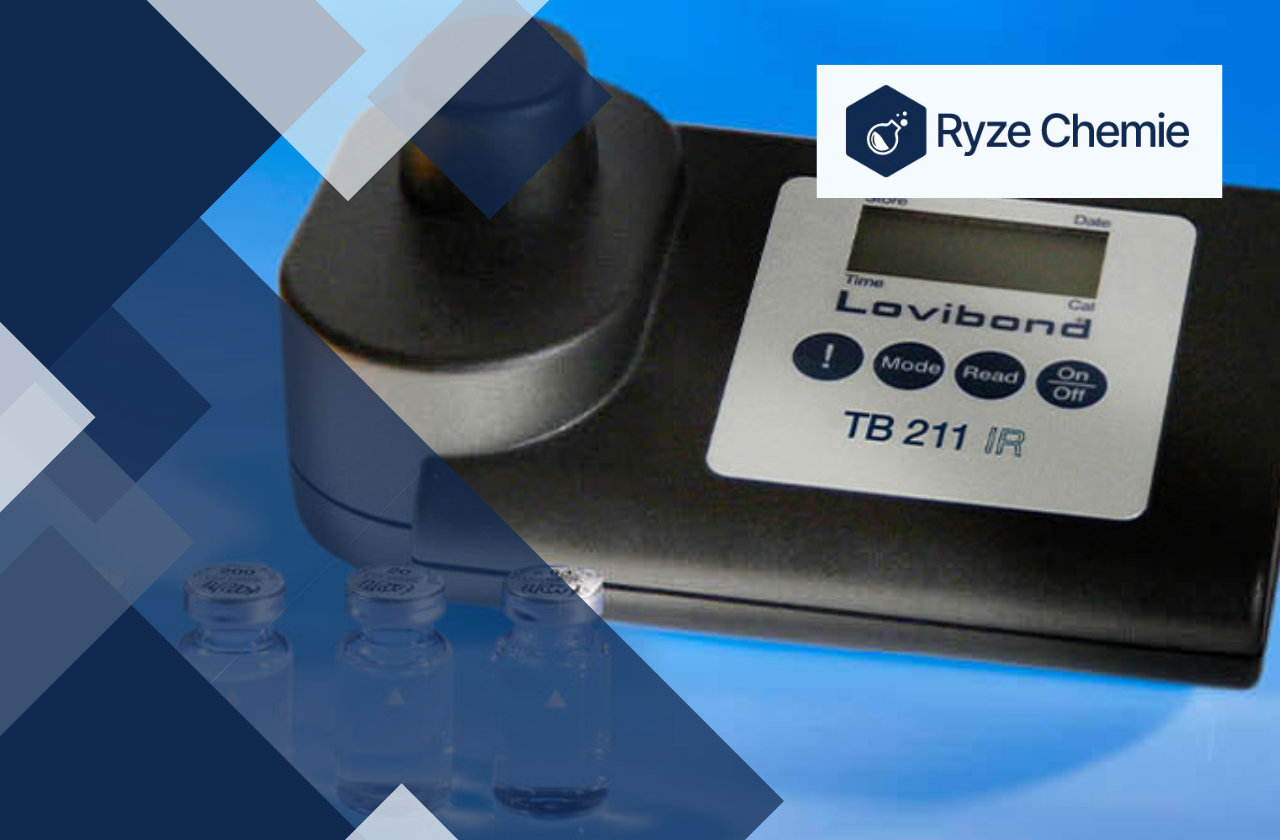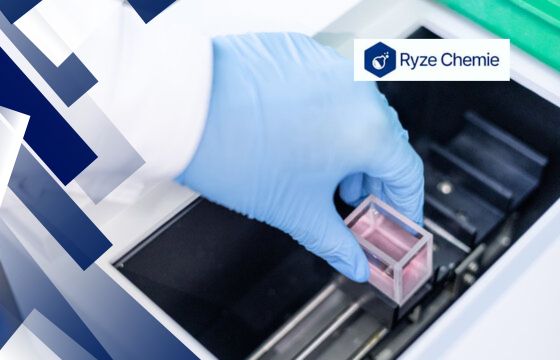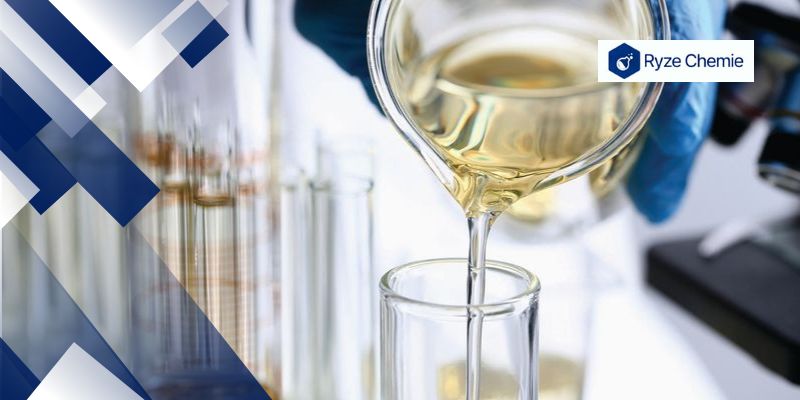
Stay up-to date on the
latest blogs. Join our
newsletter today!
This site is protected by reCAPTCHA and the Google Privacy Policy and Terms of Service apply.
What Is a Turbidimeter? All You Need To Know

Written by Team Ryze Chemie
9 mins read · Jun 11, 2024

In the laboratory, a scientist meticulously prepares a water sample for analysis. Little does they know, a seemingly insignificant error in turbidity measurement will lead to a cascading chain of events – inaccurate data, compromised research findings, and potentially, serious consequences for public health.
This anecdote underscores the critical importance of accurate turbidity measurement in a myriad of applications, from ensuring safe drinking water to monitoring industrial processes.
What is Turbidity?
Turbidity is a fundamental parameter in water quality assessment. It refers to the cloudiness or haziness of a fluid caused by individual particles suspended within it. These particles, often too small to be seen with the naked eye, scatter light, making the fluid appear turbid. Turbidity is not a direct measure of specific contaminants but rather an indicator of the overall presence of suspended solids, which can include silt, clay, algae, bacteria, and other organic or inorganic matter.
So, turbidity is about particles in a liquid. But why should we care about these particles? Let's look at why measuring turbidity is important.
Why Measure Turbidity?
Turbidity isn't just about how a liquid looks. It tells us about the safety and quality of the chemicals we use. The measurement of turbidity serves as a vital tool in various fields:
- Water Quality Assessment: Turbidity is a key parameter for assessing the quality of drinking water and wastewater. High turbidity can indicate the presence of harmful microorganisms or pollutants, making it a crucial parameter to monitor and control.
- Environmental Monitoring: In environmental studies, turbidity is used to assess the health of rivers, lakes, and oceans. Elevated turbidity can be a sign of pollution or natural disturbances, such as sediment runoff or algal blooms, which can have detrimental effects on aquatic ecosystems.
- Industrial Processes: In industries such as pharmaceuticals, food and beverage production, and chemical manufacturing, turbidity control is essential to ensure product quality and safety. For instance, high turbidity in pharmaceuticals could indicate contamination, while in the food industry, it can affect the appearance and taste of products.
- Research Applications: Turbidity measurement is also widely used in research laboratories for various applications, such as studying particle behavior, monitoring cell cultures, and evaluating the effectiveness of filtration systems.
Understanding why we measure turbidity is key. Now, let's explore how we actually measure it with a tool called a turbidimeter.
How a Turbidimeter Works
Turbidimeters are instruments designed to measure turbidity. The core principle behind their operation is nephelometry, the measurement of scattered light by particles in a fluid.
Components of a Turbidimeter:
- Light Source: Turbidimeters use various types of light sources, such as tungsten lamps, LEDs, or lasers. The choice of light source depends on the specific application and desired sensitivity. Tungsten lamps are cost-effective but have a limited lifespan, while LEDs offer energy efficiency and longevity. Lasers provide the highest sensitivity for low turbidity measurements.
- Sample Cell or Cuvette: The sample to be measured is placed in a transparent cell or cuvette, allowing the light to pass through it. The quality of the cuvette material is crucial, as scratches or imperfections can affect the accuracy of the measurement.
- Detectors: Turbidimeters employ detectors, such as photodiodes or photomultiplier tubes (PMTs), to measure the intensity of scattered light. PMTs offer superior sensitivity for low turbidity readings but are more expensive than photodiodes.
- Signal Processing Electronics: The electrical signals generated by the detectors are processed and converted into turbidity readings, typically displayed in Nephelometric Turbidity Units (NTU).
Types of Turbidimeters:
- Benchtop Turbidimeters: These are larger, more sophisticated instruments primarily used in laboratory settings for precise and accurate measurements. They often offer features like data logging, multiple measurement modes, and advanced data analysis capabilities.
- Portable Turbidimeters: Designed for field use, portable turbidimeters are compact, battery-powered, and often ruggedized to withstand harsh environments. They are commonly used for on-site water quality testing, environmental monitoring, and industrial process control.
- Online/Continuous Turbidimeters: These instruments are installed directly in pipelines or tanks to provide continuous monitoring of turbidity. They are essential in industries where real-time data and process control are critical, such as water treatment plants and chemical manufacturing facilities.
Turbidimeters are clever tools, but their results aren't just random numbers. Let's look at the units and standards we use to understand these measurements.
Measurement Units & Standards
Like with length or weight, turbidity has units of measurement. These units help us compare different samples and make sure our results are accurate:
Common Units:
- Nephelometric Turbidity Units (NTU): This is the most widely used unit for turbidity measurement. It is based on the comparison of the scattered light intensity of the sample to a standard reference suspension of formazin.
- Formazin Nephelometric Units (FNU): FNU is similar to NTU and is often used interchangeably, especially in Europe.
- Formazin Attenuation Units (FAU): FAU is another unit used to express turbidity, particularly in older instruments. It measures the attenuation (reduction) of light intensity as it passes through the sample.
Calibration & Standards:
Calibration is essential to ensure the accuracy of turbidity measurements. It involves comparing the instrument's response to known standards to adjust its readings accordingly. Formazin is the most commonly used standard for turbidity calibration. It is a synthetic polymer suspension that provides a stable and reproducible reference for turbidity measurements.
Relationship to Other Parameters:
Turbidity is often correlated with total suspended solids (TSS), which refers to the dry weight of suspended particles in a sample. However, it's important to note that turbidity is an optical measurement and may not always align perfectly with TSS, as the size, shape, and composition of particles can influence light scattering. Turbidity is not a direct indicator of specific contaminants, but high turbidity can indicate the potential presence of harmful substances.
Now that we understand the units, it's time to find the right turbidimeter for our specific needs. Let's talk about what to consider when choosing one.
Choosing the Right Turbidimeter
Not all turbidimeters are the same. Some are simple, and some are complex. Selecting the appropriate turbidimeter depends on several factors:
- Range of Measurement: Consider the expected turbidity range of your samples. Some turbidimeters are optimized for low turbidity (e.g., drinking water), while others are designed for high turbidity (e.g., wastewater).
- Accuracy and Precision: Determine the level of accuracy and precision required for your application. Research laboratories may need high-precision instruments, while field measurements may prioritize portability and ease of use over extreme precision.
- Sample Type: The nature of your samples will influence your choice. Some turbidimeters are specifically designed for water or wastewater, while others can handle a wider range of fluids, including chemicals or beverages.
- Regulatory Requirements: If your measurements need to comply with specific regulations (e.g., drinking water standards), ensure the turbidimeter meets those requirements.
- Budget and Features: Turbidimeters vary widely in price and features. Consider your budget and the specific features you need, such as data logging, multiple measurement modes, or automatic calibration.
Leading Manufacturers and Models:
Reputable manufacturers of turbidimeters include Hach, Thermo Scientific, WTW (Xylem Analytics), and LaMotte. Their models range from basic portable units to advanced laboratory instruments with a wide array of features. Research and compare different models to find the one that best suits your needs and budget.
Having the right turbidimeter is important, but we also need to know how to use it correctly. Let's go over some practical tips.
Practical Tips for Using a Turbidimeter
Using a turbidimeter might seem difficult, but it's easier than you think. With a few simple steps, we can get accurate results every time:
Sample Preparation:
- Collect samples carefully, following established protocols to avoid contamination or disturbance of suspended particles.
- If the sample's turbidity is outside the instrument's range, consider filtration or dilution to bring it within measurable limits.
Calibration Procedures:
- Always calibrate the turbidimeter before use, following the manufacturer's instructions.
- Prepare formazin standards carefully, ensuring they are free of bubbles or contamination.
- Verify calibration regularly, especially if the instrument is used frequently or if the sample types vary.
Troubleshooting Common Issues:
- Bubbles: If bubbles are present in the sample cell, they can scatter light and cause inaccurate readings. Gently tap the cell to dislodge bubbles or use a syringe to remove them.
- Debris: Remove any visible debris from the sample cell before measurement.
- Interfering Substances: Some substances, such as highly colored samples or those with high dissolved solids, can interfere with turbidity measurement. Consider filtration or dilution to minimize these effects.
- Cleaning and Maintenance: Regularly clean the sample cell and optical components according to the manufacturer's recommendations. This will help maintain accuracy and prolong the instrument's lifespan.
Data Interpretation:
- Understand the meaning of different turbidity readings in the context of your application. For instance, a turbidity reading of 5 NTU might be acceptable for drinking water, while a reading of 100 NTU might indicate a problem in a wastewater treatment plant.
- Be aware of potential sources of error, such as improper calibration, sample contamination, or instrument malfunction.
The basics are important, but there's even more to turbidimetry. Let's look at some advanced techniques we can use for more complex measurements.
Advanced Turbidimetry Techniques
For certain situations, we need more than the basic turbidity measurement. Advanced techniques can help us get even more information from our samples:
- Ratio Turbidimetry: This technique uses multiple detectors placed at different angles to measure scattered light. By comparing the signals from these detectors, ratio turbidimeters can compensate for variations in particle size and shape, leading to more accurate measurements.
- Laser Nephelometry: Laser nephelometry employs lasers as light sources, offering higher sensitivity and precision than traditional turbidimeters. This is particularly advantageous for low turbidity measurements and research applications where high accuracy is critical.
- Emerging Technologies: The field of turbidimetry continues to evolve, with advancements such as online turbidity sensors that provide real-time data logging and remote monitoring capabilities. These technologies are increasingly used in industrial environments for process optimization and quality control.
Conclusion
Turbidity measurement plays a pivotal role in diverse fields, from ensuring the safety of our drinking water to monitoring industrial processes. Understanding the principles of turbidimetry, choosing the right instrument, and following proper procedures are essential for obtaining accurate and reliable data. As technology continues to advance, we can expect even more sophisticated and user-friendly turbidimeters to emerge, further enhancing our ability to monitor and control turbidity in various applications.
Latest Blogs








